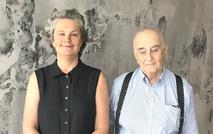Cachexia Detection and Lignin Extraction Projects, and Nanotech for Skin Grafts and Silicon Chips Win CHF 10,000
27.06.2019
Swiss university spin-off projects Adiposs, Bloom Biorenewables, Nanoglue and Nanotech SWHL each win Venture Kick’s support and training. The founders aim to save lives, cut carbon emissions in the flavors & fragrances industry, improve wound treatment, and accelerate computer chip production.
 Venture Kick winners Adiposs, Bloom Biorenewables, Nanoglue and Nanotech SWHL
|
 Adiposs CEO and co-founder Andrej Babic
|
 Bloom co-founders Florent Héroguel, COO, and Remy Buser, CEO
|
 Nanoglue co-founders Sebastian Loy, Tino Matter, and Daria Höhener
|
 Nanotech SWHL co-founders Natasha Ivanova and Vadim Rakhovskiy
|
Adiposs: detecting Cachexia earlier
Cancer cachexia is a serious body-wasting syndrome characterized by involuntary body weight loss. It affects more than half of cancer patients, and is the cause of death in a fifth of cancer patients. Adiposs is developing a contrast agent to detect cachexia earlier, with a simple, fast, inexpensive and pain-free computed tomography scan. The innovation for reliable, early detection, by a co-founders University of Geneva lecturer Andrej Babic and Justyna Plewka, may help the 9 million new cancer patients at highest risk of cachexia.
venturekick.ch/Adiposs
venturekick.ch/Adiposs
Bloom Biorenewables Sàrl: efficient lignin extraction for flavors & fragrances
Bloom's high-yield technology extracts lignin, a vital molecule for the flavors and fragrances industry, from 'waste' plant material leftover from paper production. EPF Lausanne researcher Florent Héroguel's patented, low-temperature process offers a way for the chemical industry to reduce its emissions of greenhouse gases. With co-founders Remy Buser and Jeremy Luterbacher the team looks to bring its petroleum-alternative to market with industry partners.
Bloom's high-yield technology extracts lignin, a vital molecule for the flavors and fragrances industry, from 'waste' plant material leftover from paper production. EPF Lausanne researcher Florent Héroguel's patented, low-temperature process offers a way for the chemical industry to reduce its emissions of greenhouse gases. With co-founders Remy Buser and Jeremy Luterbacher the team looks to bring its petroleum-alternative to market with industry partners.
Nanoglue: making skin grafts stick
The $19 billion wound care market is growing as societies age and diabetes becomes more prevalent. Millions of skin graft operations are performed every year, yet ten percent of them fail. Skin-graft-rejection exposes injured patients to further discomfort, the risk of infection, and longer hospital stays. St. Gallen-based Nanoglue's co-founders Sebastian Loy, Tino Matter, Daria Höhener and Nicolas Gilgen are using nanotechnology developed at ETH Zurich to make a simple paste that will help skin grafts stick, boosts the body's healing, and reduce the risk of infectious bacteria in the wound.
Nanotech SWHL: faster, high-res lithography for chips
The miniaturization of computer chips has reduced the margin for error in their production. Smaller integrated circuits must be produced using higher resolution lithography. EMPA-spin-off Nanotech's sub-wavelength holographic lithography lets chipmakers to achieve high-resolution images more efficiently than alternative lithography production methods. The technology applicable for microelectronics, micro optics, smart packaging and LEDs, will allow faster production at a resolution of less than 250 nanometers, co-founders Natasha Ivanova and Vadim Rakhovskiy say.


